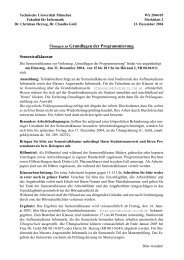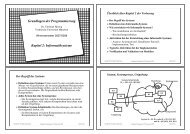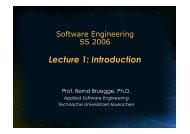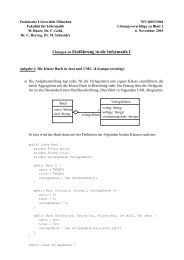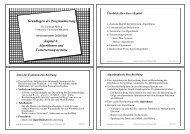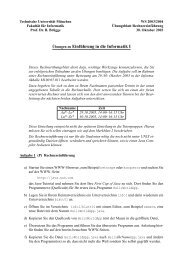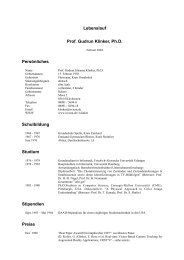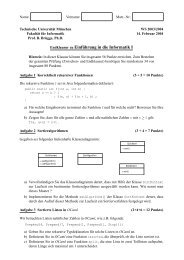Sheet 1 - Technische Universität München
Sheet 1 - Technische Universität München
Sheet 1 - Technische Universität München
You also want an ePaper? Increase the reach of your titles
YUMPU automatically turns print PDFs into web optimized ePapers that Google loves.
<strong>Technische</strong> Universität München<br />
Software-Engineering Exercises<br />
Fakultät für Informatik Winter 2005/2006<br />
Prof. B. Bruegge, Ph. D. <strong>Sheet</strong> 1<br />
Lilith Al-Jadiri 10/27/2005<br />
Modeling with UML: Use cases and class diagrams<br />
Note: Contrary to what was announced in the first lecture, handing in of the exercise sheets<br />
is not mandatory for exam admission. The mini-project, however, is mandatory and<br />
contributes to 20% of the final acquired grade.<br />
Exercise 1<br />
Consider an ATM system. Identify at least three different actors that interact with this system.<br />
Exercise 2<br />
Can the system under consideration be represented as an actor Justify your answer.<br />
Exercise 3<br />
What is the difference between a scenario and a use case When do you use each construct<br />
Exercise 4<br />
Draw a use case diagram for a ticket distributor for a train system. The system includes two actors:<br />
a traveler, who purchases different types of tickets, and a central computer system, which maintains a<br />
reference database for the tariff. Use cases should include: BuyOneWayTicket, BuyWeeklyCard,<br />
BuyMonthlyCard, UpdateTariff. Also include the following exceptional cases: Time-Out (i.e., traveler took<br />
too long to insert the right amount), TransactionAborted (i.e., traveler selected the cancel button without<br />
completing the transaction), DistributorOutOfChange, and DistributorOutOfPaper.<br />
Exercise 5<br />
Write the flow of events and specify all fields for the use case UpdateTariff that you drew in Exercise<br />
4. Do not forget to specify any relationships.<br />
Exercise 6<br />
Draw a class diagram representing a book defined by the following statement: “A book is composed<br />
of a number of parts, which in turn are composed of a number of chapters. Chapters are composed<br />
of sections.” Focus only on classes and relationships.<br />
Exercise 7<br />
Add multiplicity to the class diagram you produced in Exercise 6.<br />
Exercise 8<br />
Draw an object diagram representing the first part of the OOSE book containing the following<br />
content:<br />
1
Book: OOSE<br />
Table of Contents:<br />
Part 1: Getting Started<br />
Chapter 1: Introduction of Software Engineering<br />
1.1 Introduction: Software Engineering Failures<br />
1.2 What is Software Engineering<br />
1.3 Software Engineering Concepts<br />
1.4 Software Engineering Development Activities<br />
1.5 Managing Software Development<br />
1.6 Exercises<br />
References<br />
Chapter 2: Modeling with UML<br />
2.1 Introduction<br />
2.2 An Overview of UML<br />
2.3 Modeling Concepts<br />
2.4 A Deeper View into UML<br />
2.5 Exercises<br />
References<br />
Chapter 3: Project Communication<br />
3.1 Introduction<br />
3.2 An Overview of Project Communication<br />
3.3 Models of Communication<br />
3.4 Mechanisms of Communication<br />
3.5 Project Communication Activities<br />
3.6 Exercises<br />
References<br />
Make sure that the object diagram you draw is consistent with the class diagram of Exercise 6.<br />
Exercise 9<br />
Extend the class diagram of Exercise 6 to include the following attributes:<br />
• book includes a publisher, publication date, and an ISB<br />
• a part includes a title and a number<br />
• a chapter includes a title, a number, and an abstract<br />
• a section includes a title and a number<br />
Exercise 10<br />
Consider the class diagram of Exercise 9. Note that the Part, Chapter, and Section classes all include a<br />
title and a number attribute. Add an abstract class and a generalization relationship to factor out<br />
these two attributes into the abstract class.<br />
Exercise 11<br />
Draw a class diagram representing the relationship between parents and children. Take into account<br />
that a person can have both a parent and a child. Annotate associations with roles and<br />
multiplicities.<br />
2



